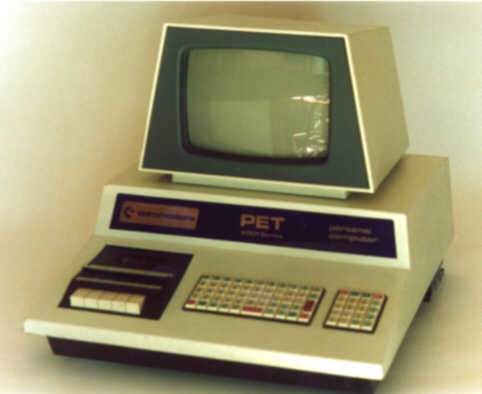History of computer design: Commodore PET
4-frogdesign || 5-Corporate focus || Conclusion || Bibliography & links
![]()
![]()
 The Apple II, however influential, did not
give the outward appearance of personal computers a stable
form, and a variety of different case designs were mass
produced between 1977 and 1981. Most shared the integration
of the keyboard into the computer case. However, it is
important to note that even the design of keyboards lacked a
standard, and Byte
magazine continued to emphasize the layout and characters of
keys in each of its computer reviews until late 1985. The
keyboard of
Commodore
Computer's PET was particularly criticized; its keys are
small, flat and cramped together like those of a calculator
- Commodore branched into personal computers from its
manufacture of calculators - rather than a typewriter
(Comly, 120).
The Apple II, however influential, did not
give the outward appearance of personal computers a stable
form, and a variety of different case designs were mass
produced between 1977 and 1981. Most shared the integration
of the keyboard into the computer case. However, it is
important to note that even the design of keyboards lacked a
standard, and Byte
magazine continued to emphasize the layout and characters of
keys in each of its computer reviews until late 1985. The
keyboard of
Commodore
Computer's PET was particularly criticized; its keys are
small, flat and cramped together like those of a calculator
- Commodore branched into personal computers from its
manufacture of calculators - rather than a typewriter
(Comly, 120).
The Commodore PET was announced at the same West Coast Compute Faire where the Apple II was introduced, but was not sold for nearly a year. Though having an integrated display and sold at only $595, about half the price of an Apple II, the "2001 Series" PET (Personal Electronics Transactor) was less popular in homes than in schools, while the Apple II continued to be the most popular in both settings (Comly, 127). Vaguely resembling the form of the Apple II, the PET case has a wedge sloping towards the user and containing the small integrated keyboard, numeric keypad, and a tape drive. The attached 9 inch monochrome display is centered on the larger back portion of the case. This display gives the unit a vaguely anthropomorphic appearance, being elevated above the rest of the case by a narrow pillar resembling a neck. The sides of the tetrazoidal display sloping outwards towards the bottom enhance this effect, giving the impression that the head is wearing a hood. However, this tiered design does not take away from the bulky appearance of the machine, which is 14 inches high and weighs 44 pounds, and its sheet metal casing and awkward keyboard contribute to its industrial appearance.
Home || Introduction || Historiography || 1-Cottage industry || 2-Emerging standards || 3-Macintosh
4-frogdesign || 5-Corporate focus || Conclusion || Bibliography & links







.jpg)








